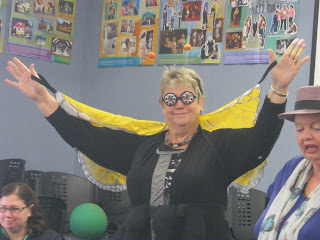Today Madam Butterfly came to our school. She is a kaitiaki because she cares for all the butterflies. I learned that many butterflies are in NZ. The part I liked was watching the caterpillar transform to a Monarch Butterfly. V.V.
Today, June 28, Madam Butterfly came to our school. She is a kaitiaki because butterflies are part of our Earth. I learned that they are not extinct. The part I enjoyed most was when Mrs A was dressed as a Monarch Butterfly. Madam Butterfly is very interested in butterflies. J.V.
Today Madam Butterfly came to our school. She is a kaitiaki because she knows about butterflies and looks after butterflies. M.L.
Madam Butterfly is a kaitiaki because she looks after a type of animal called a Monarch Butterfly. I learned that butterflies are special. The part I enjoyed most was seeing Mrs A as a butterfly. It was crazy and funny. I could laugh for 900,000,000,000 years until the world has ended. Caring for butterflies and moths is important because they are in the biospherre. G.S.
Madam Butterfly is a kaitiaki because she takes care of butterflies. She started the organisation Moths and Butterflies NZ Trust and she studies about butterflies. I learned that there are 20,000 species of butterflies. The part I enjoyed most was when Mrs A got dressed as a butterfly. Taking care of butterflies is a good thing so there will always be more of them. A.K.
Madam Butterfly founded the Moths and Butterflies of NZ Trust. She also really cares for butterflies. I learned there are 20,000 species of butterflies worldwide! The part I enjoyed most was laughing so hard my stomach hurt when Mrs A blew the butterfly tongue! K.J.
Madam Butterfly is a kaitiaki because she studies butterflies and helps them. I learned that butterflies might be threatened but not endangered or extinct. The part I enjoyed most was when Madam Butterfly dressed up Mrs A as a butterfly. Madam Butterfly's job is important because not a lot of people care for butterflies so she cares for them. H.K.
Madam Butterfly looks after Monarch Butterflies, Red Admiral, Cabbage White, Coppers, Common Blue and Magpie Moths. I learned there are lots of species. The part I enjoyed most was when Mrs A dressed up as a butterfly. It was interesting because Madam Butterfly had a collection of butterflies. A.M.
So here is the part we all enjoyed..............































